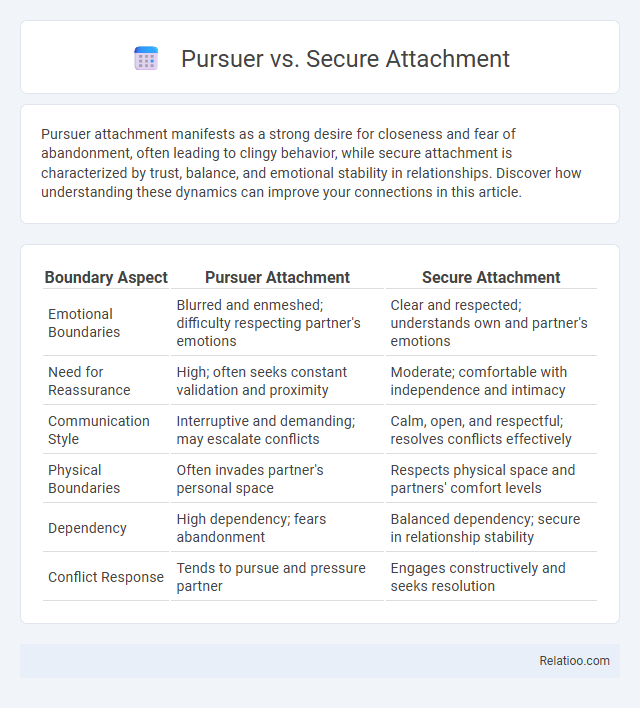Pursuer attachment manifests as a strong desire for closeness and fear of abandonment, often leading to clingy behavior, while secure attachment is characterized by trust, balance, and emotional stability in relationships. Discover how understanding these dynamics can improve your connections in this article.
Table of Comparison
| Boundary Aspect | Pursuer Attachment | Secure Attachment |
|---|---|---|
| Emotional Boundaries | Blurred and enmeshed; difficulty respecting partner's emotions | Clear and respected; understands own and partner's emotions |
| Need for Reassurance | High; often seeks constant validation and proximity | Moderate; comfortable with independence and intimacy |
| Communication Style | Interruptive and demanding; may escalate conflicts | Calm, open, and respectful; resolves conflicts effectively |
| Physical Boundaries | Often invades partner's personal space | Respects physical space and partners' comfort levels |
| Dependency | High dependency; fears abandonment | Balanced dependency; secure in relationship stability |
| Conflict Response | Tends to pursue and pressure partner | Engages constructively and seeks resolution |
Understanding Attachment Styles: An Overview
Understanding attachment styles involves recognizing the dynamics between Pursuer and Secure Attachment types, where Pursuers often seek closeness and reassurance, while Secure Attachment individuals maintain balance and trust in relationships. Pursuers tend to experience anxiety and fear of abandonment, prompting persistent efforts to connect, whereas Secure Attachment is characterized by confidence, effective communication, and emotional regulation. This contrast highlights how attachment security fosters healthy interpersonal boundaries, whereas a Pursuer stance can lead to relational tension without mutual security.
Defining the Pursuer Attachment Pattern
The Pursuer attachment pattern is characterized by a persistent need for closeness and reassurance, often driven by fear of abandonment and insecurity within relationships. Individuals with this attachment style typically seek constant communication and emotional validation, which can create tension when their partner prefers more independence. Contrastingly, the Secure attachment involves balanced intimacy and autonomy, fostering mutual trust and effective emotional regulation.
Key Traits of Secure Attachment
Secure attachment is characterized by trust, effective communication, and emotional availability, fostering healthy, balanced relationships. Individuals with secure attachment maintain boundaries while expressing needs openly, promoting mutual respect and understanding. This contrasts with pursuers who often exhibit anxiety and seek reassurance excessively, leading to relational tension.
Pursuer vs Secure: Core Differences
Pursuer attachment is characterized by a strong desire for closeness and fear of abandonment, often leading to anxiety and clinginess in relationships. Secure attachment involves confidence in self-worth and trust in others, enabling healthy boundaries and balanced emotional expression. The core difference lies in emotional regulation: pursuers seek reassurance due to insecurity, while securely attached individuals maintain stability through self-assurance and mutual respect.
Childhood Origins of Pursuer and Secure Attachments
Pursuer attachment often originates from inconsistent caregiving in childhood, where the child learns to seek proximity and reassurance due to feelings of insecurity or neglect. Secure attachment develops through responsive and reliable caregiving, fostering trust and emotional regulation in the child. Childhood experiences shape these attachment styles by influencing whether the child feels safe to explore or driven to seek constant connection.
Communication Styles in Pursuer and Secure Partners
Pursuer attachment styles often exhibit high communication frequency driven by anxiety about relationship stability, characterized by seeking reassurance and expressing needs intensely. Secure partners demonstrate balanced communication, combining openness with active listening and emotional attunement, fostering mutual understanding without overwhelming pressure. This dynamic promotes healthier conflict resolution and emotional regulation, differentiating secure attachment from the more demanding and sometimes intrusive communication of pursuers.
Emotional Regulation in Pursuer vs Secure Attachment
Pursuers often struggle with emotional regulation, exhibiting heightened anxiety and a strong need for reassurance in relationships, which contrasts sharply with those exhibiting secure attachment who maintain balanced emotional responses and effective self-soothing abilities. Secure attachment fosters emotional stability and resilience by promoting trust and communication, enabling individuals to manage conflicts without excessive distress or dependency. In contrast, pursuers may engage in persistent pursuit behaviors driven by difficulties in regulating negative emotions, leading to challenges in maintaining healthy relational dynamics.
Relationship Dynamics: Pursuer and Secure Interactions
In relationship dynamics, a pursuer typically seeks closeness and reassurance, often displaying anxiety about emotional availability, while a secure partner maintains steady communication and emotional stability, fostering trust and balance. Secure attachment provides a calm and consistent response to the pursuer's needs, which helps reduce conflict and promotes mutual understanding. This dynamic encourages healthier boundaries and emotional regulation, enabling both partners to grow and feel valued within the relationship.
Challenges and Growth Paths for Pursuer Types
Pursuer attachment types often face challenges related to fear of abandonment and overdependence in relationships, which can lead to difficulty respecting boundaries and creating emotional distance. Growth paths for Pursuers include developing self-awareness to recognize anxious behaviors, practicing healthy communication to express needs without overwhelming their partner, and building self-regulation skills to manage attachment anxiety. By fostering emotional resilience and secure boundaries, You can transform anxious patterns into secure relational dynamics, enhancing intimacy and connection.
Cultivating Secure Attachment in Relationships
Cultivating secure attachment in relationships enhances emotional stability and mutual trust, reducing the conflict seen in Pursuer vs Secure Attachment dynamics. You benefit from fostering open communication and consistent support, which create a safe environment where both partners feel valued and understood. Prioritizing these elements helps transform Pursuer tendencies into balanced, secure connections that promote long-term relationship satisfaction.

Infographic: Pursuer vs Secure Attachment
 relatioo.com
relatioo.com